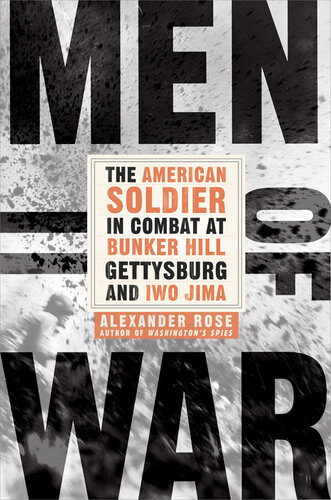
Men of War
The American Soldier in Combat at Bunker Hill, Gettysburg, and Iwo Jima
کتاب های مرتبط
- اطلاعات
- نقد و بررسی
- دیدگاه کاربران
نقد و بررسی

June 22, 2015
Inspired by the experience of the British soldier in John Keegan's The Face of Battle, a classic work of military history, Rose (The American Rifle) looks at three iconic battles in American military historyâBunker Hill, Gettysburg, and Iwo Jimaâthrough the American soldier's perspective, mining an immense database of secondary and primary sources to relate the experience of battle largely in the words of the soldier participants. Rose takes the reader into the firing line with the smoke and horror of combat. One consistent theme that he illuminates is the constant danger of infantry combat: the risk of death or injury is high, and the wounds, both fatal and non-fatal, are often gruesome. The detailed descriptions of the state of medical support for wounded soldiers is another important focus, and Rose makes the point that medical science, even in the relatively modern battle of Iwo Jima in 1945, was strained by the needs of the wounded. The physiological impact on the survivors of battle is also stressed throughout. Rose's grim, unadorned, yet immensely readable look at battle is a dose of what real war is like, and a good balance to the more common sanitized military history fare.

Starred review from March 15, 2015
A close look at three of the iconic battles in American history, as experienced by the men on the front lines. In the introduction, Rose (American Rifle: A Biography, 2008, etc.) writes that John Keegan's The Face of Battle (1976) inspired him to write an American version of the same theme. The three battles chosen show the changing nature of warfare. Rose is skeptical of the concept that there is a universal experience of war, arguing that each era has its own ways of fighting and its own codes of military conduct. For each battle, the author draws on the accounts of ordinary soldiers to build the larger picture in mosaic fashion. At Bunker Hill, American militia went up against British regulars. Rose shows that the British were overconfident, while the militiamen had leaders experienced in the French and Indian War and plenty of time drilling. At Gettysburg, two seasoned armies were opposed. By the military doctrine of the day, emphasizing the frontal attack, Robert E. Lee's army was almost obligated to assault the Union lines. At the same time, soldiers in a failed assault were allowed to surrender with honor, unlike their ancestors at Bunker Hill. Iwo Jima, the longest battle profiled here, produced a devastating body count on both sides. The U.S. Marines and their Japanese opponents gave no quarter; few Japanese survived the battle, and the Marines took losses that would have dissuaded almost any other body of men. Rose builds up a detailed picture of each of these battles, sparing few gritty details and romanticizing almost nothing. He writes vividly and memorably, with a good eye for the telling detail or anecdote as well as big-picture perspectives. It's particularly enlightening to have his detailed examinations of Bunker Hill and Iwo Jima, which have received far less attention from military historians than Gettysburg-but even that account benefits from the larger context in which this book places it. A highly recommended addition to the literature of military history.

May 1, 2015
Journalist Rose's (Washington's Spies; American Rifle) latest work follows a similar pattern to John Keegan's classic The Face of Battle, for which Rose professes admiration. Relating to its title, Rose's book appropriately focuses on the individual soldier's experiences at Bunker Hill (1775) in the Revolutionary War, Gettysburg (1863) in the Civil War, and Iwo Jima (1945) in World War II: battles chosen because they were iconic rather than decisive. Chapters contain summaries of the events and maneuvers at the relevant battles, interspersed with depictions of those who fought. Some of the details include descriptions of soldiers' backgrounds, professions, and motivations, as well as equipment and supplies such as weapons, clothing, and even food. There is occasional emphasis on biological reactions to combat--heart rates, adrenaline, eye dilation, fatigue, and overall bodily control. In addition to weapons carried and operated on the field, Rose describes resulting wounds in detail along with the fates of those who suffered them, both immediately and in the long term. VERDICT This worthy homage to The Face of Battle puts an American twist on Keegan's formula. Recommended for anyone interested in U.S. military history.--Matthew Wayman, Pennsylvania State Univ. Lib., Schuylkill Haven
Copyright 2015 Library Journal, LLC Used with permission.

























دیدگاه کاربران